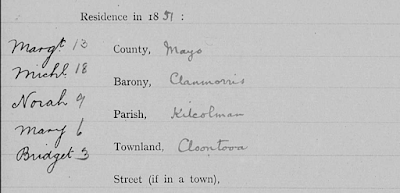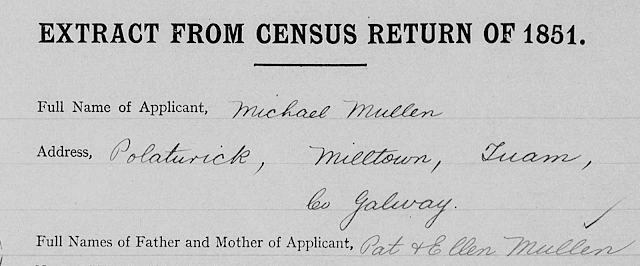These forms provided me with the maiden names of two of my 2nd great-grandmothers and the marriage dates of two ancestral couples. Anyone 70 and older, who met the income requirements, and wasn't recently released from prison, was entitled to a pension. They applied at the post office and their pension was paid to them at the post office.
I've been taking a second look at the pension extract forms to try to figure out more precisely when my ancestors were born. My great-great grandparents' ages vary between 10 and 15 years in the various records I've collected. In one record my great-great grandmother was born before her parents' marriage. According to her death record she would have been a child when her daughter Ellen was born.
Here is what I've gleaned through closer examination of these records.
Information Provided by applicant (upper portion)
The information above the centered line, in the mid portion of the form, was mostly what was provided by the applicant. The notations above the line in code were of course made by the office staff. The applicant provided the information which included parents' names and the location of the family in either 1841 or 1851.
Please state how old you were and the names of your siblings
There are many common surnames and first names in certain locations in Ireland. The extractors sometimes asked applicants for the names of their siblings in order to locate the correct family. In the case below the extractor asked for the names of the siblings of this applicant in order of birth.

Below is the applicant provided information for my great-great grandmother Mary Huane-Mullen. In order to qualify for the old age pension she applied for in 1920 she would have had to have been born in 1850, or before. The names of the children are in the birth order favorable to Mary's age claim. I believe she was born after the census year of 1851; she was not found on the census. It appears that the children who were found on the census had their ages added to the list given by Mary. Ages were likely added by the extractor. It does appear the oldest children in the Huane family were 4 year old twins. The last child listed was Thomas who according to the records I've gathered was indeed the youngest. So it was common for the children to have been listed in birth order, but sometimes this order could have been changed in order to support the applicant's stated age for their pension claim.
Two Pat Donnellan families so please provide more information
This extractor requested the mother's maiden name and list of siblings to separate two families with the same name.
Ages added by extractor
Below you can see that the names are written in ink and the ages are later added in pencil from the census form.
Information added by extractor regarding child's death
Here we see a child is noted as having died. The 1841 and 1851 censuses for Ireland included a table to list deaths of household members that occurred in the past 10 years. Catherine apparently wasn't found. Again the sibling names provided by the applicant were provided with the ages on the census form by the extractor.
Extractor adds absent to Pats name
There was also a table on the 1841 and 1851 censuses for household members absent on census night. Below absent was added to Pat's name because he appeared listed in that table. The extractor doesn't add the ages of family members because he does that below the line, instead, as we will see.
Step-sisters noted
Two of the household members below were step-sisters. These forms can provide additional information about relationships.
Information extracted by pension officials (below mid portion of form)
Marriage date as recorded in the census
Adults were asked for their marriage year if married, they were asked on the 1841 and 1851 censuses. The early 20th century pension applicants were generally living with their parents in those census years. It's also possible that a few of the applicants were themselves married during the census years. Below is the extracted information for my 2nd great-grandparents Patt & Nelly Mullen who were married in 1837, according to the census. I have found their marriage record and they were married in 1837.
Lists of siblings of applicants names and ages extracted by officials
These lists appear below the midpoint line on the form. Here we see a list extracted from the actual census rather than provided by the applicant. The list includes ages and information from the death table on the census. Below we see a sibling of the applicant Pat died at age 5 in 1846, according to the census.
Sometimes the extractor went above and beyond
This extractor included a great deal of additional information from the census. This extract was made by the same person who added absent to Pat's name in the example from the applicants portion. This extractor noted they checked the absent table and death table of the census and reported what they found. I had wondered if all tables were checked. They also included the fact one household member was a nephew.
Bap note what is that?
I've seen "bap note" recorded on some of the pension forms. I have noticed pension payment amounts are recorded on forms even when the person wasn't found on the census. I wonder if a baptismal record was used instead of the census?
In my great-great uncle's case it seems that a bap note informed them of the death of Michael's sibling, also named Michael, who died in 1848. I had assumed the death information came from the table in the 1851 census? There is an arrow pointing from the notation to this information. It was common for deaths to be recorded in the church books below a person's baptism.
Michael Mullen isn't an uncommon name so that could be why he applied again giving his mother's maiden name. Another Michael Mullen could have died in 1848 from a family with the same parents' names. He apparently received his pension or at least a sum for a pension is recorded. His annual award would have been £16.14 annually.
Certificate of Baptism as alternative
This note on a pension form implies that a baptism certificate could also serve as proof of birthdate. This applicant wanted the large town, near where my own ancestors lived, searched for the family. Without a street name the office wouldn't undertake such a large area search. It was suggested they get a copy of the baptismal certificate. I believe O.A.P means Old Age Pension.
A side note
My great-great grandmother appears on two pension extraction forms. For some reason her name is crossed out and her brother John's name is added. Her address is given on both forms, and both forms state she was not found. John, however, was found and likely received a pension. Or was her name mistakenly written as John on the census? It's a mystery.
I'm beginning to be able to decipher these forms after reviewing many of them. It's an interesting subject and not much has been written about these pension forms.
If anyone has any corrections or additional information please let me know.






















